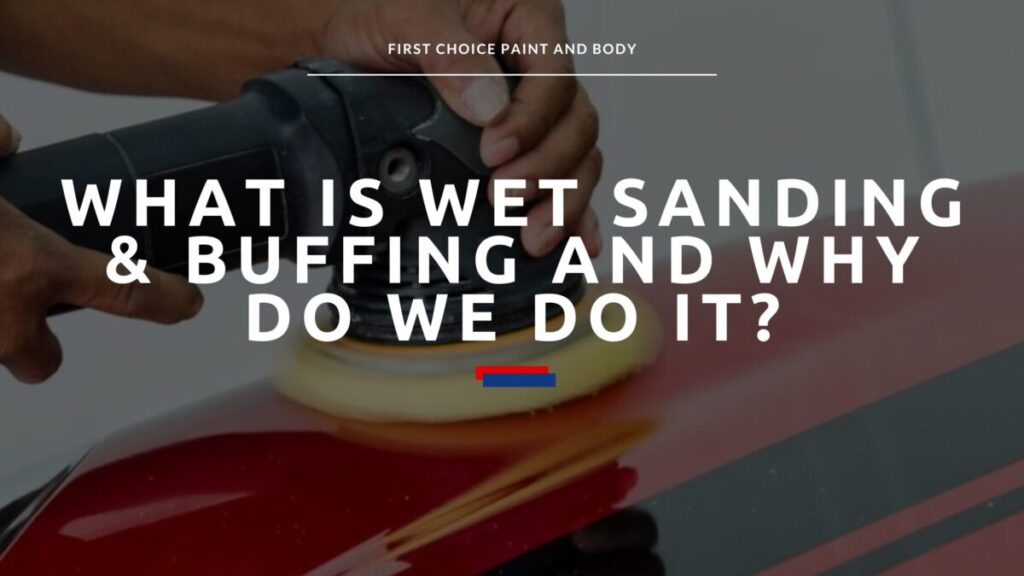What is Wet Sanding & Buffing and Why Do We Do It?

When it comes to car maintenance, enthusiasts and professionals alike are always looking for ways to keep vehicles looking their best. Two techniques that often come up in the world of auto detailing and paint correction are wet sanding and buffing. These methods are crucial for restoring and maintaining the appearance of a car’s paint job. But what exactly are wet sanding and buffing, and why do we do them? In this comprehensive guide, we’ll explore these techniques, their differences, benefits, and more.

What is Wet Sanding?
Wet sanding is a process where sandpaper is used with water to remove imperfections from a vehicle’s paint surface. This technique is commonly used to eliminate scratches, orange peel texture, and other surface defects. The water acts as a lubricant, reducing friction and preventing the sandpaper from clogging with paint particles.
Materials and Tools Needed for Wet Sanding
To get started with wet sanding, you’ll need the following materials and tools:
- Wet/Dry Sandpaper: Available in various grits, typically ranging from 1000 to 3000 grit.
- Water: A bucket of water or a spray bottle to keep the surface wet.
- Sanding Block: Ensures even pressure distribution.
- Microfiber Cloths: For cleaning and drying the surface.
- Masking Tape: To protect areas that you don’t want to sand.
Common Scenarios for Wet Sanding
Wet sanding is often used in the following scenarios:
- Removing Scratches: Light to moderate scratches that haven’t penetrated the clear coat can be smoothed out with wet sanding.
- Eliminating Orange Peel: This term describes the uneven texture that sometimes appears after a paint job. Wet sanding can create a smoother, glass-like finish.
- Preparing for Painting: Wet sanding helps create a uniform surface, making it easier for new paint to adhere properly.
What is Buffing?
Buffing is the process of polishing a vehicle’s paint to enhance its shine and smoothness. This is done using a buffer machine or a polishing pad and compound. Buffing removes fine scratches, swirls, and oxidation, resulting in a glossy finish.
Materials and Tools Needed for Buffing
For buffing, you’ll need:
- Buffer Machine: An orbital or rotary buffer.
- Polishing Pads: Different pads for various stages of buffing (cutting, polishing, finishing).
- Polishing Compound: Abrasive compounds that help remove imperfections.
- Microfiber Cloths: For wiping down the surface.
Common Scenarios for Buffing
Buffing is used in the following scenarios:
- Polishing: Enhances the shine of the paint, making it look brand new.
- Removing Swirl Marks: Often caused by improper washing or drying techniques.
- Oxidation Removal: Buffing can remove the dull, oxidized layer of paint to reveal the vibrant color underneath.
Differences Between Wet Sanding and Buffing
While both wet sanding and buffing aim to improve the appearance of a vehicle’s paint, they are distinct processes used for different purposes.
Wet sanding involves using sandpaper and water to remove deeper imperfections from the paint surface. This method is ideal for eliminating significant flaws such as scratches and orange peel texture.
On the other hand, buffing employs a buffer machine and polishing compounds to polish and enhance the paint’s shine. This technique is more suitable for refining the paint surface and adding a glossy finish. Typically, wet sanding is done before buffing because the sanding process can leave the paint looking dull. Buffing is then necessary to restore the paint’s gloss, giving the vehicle a smooth and shiny appearance.
Benefits of Wet Sanding and Buffing
Wet sanding and buffing offer several significant benefits for maintaining and enhancing your car’s appearance. Firstly, these techniques can dramatically improve the look of your car’s paint, making it smoother and shinier. The processes effectively remove light to moderate scratches and imperfections, resulting in a flawless finish. Additionally, wet sanding and buffing are essential for paint correction processes, ensuring a uniform, high-quality finish that can make a vehicle look brand new.
Potential Risks and How to Mitigate Them
Wet sanding and buffing also come with potential risks that must be carefully managed. One primary risk is paint damage. Over-sanding or excessive buffing can harm the paint, so it’s crucial to always use the correct grit sandpaper and avoid applying too much pressure. Another risk is burn-through, which occurs when a buffer is used improperly, causing the paint to wear away. To prevent this, keep the buffer moving and use the appropriate pads and compounds. Lastly, incorrect buffing techniques can leave swirl marks on the paint. Using the right pad and compound for the final polish can help avoid these unsightly marks and ensure a smooth, professional finish.
Conclusion
Wet sanding and buffing are essential techniques in car detailing and paint correction. While they serve different purposes, both processes are crucial for maintaining and restoring a car’s paint job. By understanding the steps involved and taking necessary precautions, you can achieve professional-quality results and keep your vehicle looking its best.
Whether you’re a DIY enthusiast or a professional detailer, mastering these techniques will significantly enhance your car care skills.
Back to top: What is Wet Sanding & Buffing and Why Do We Do It?
